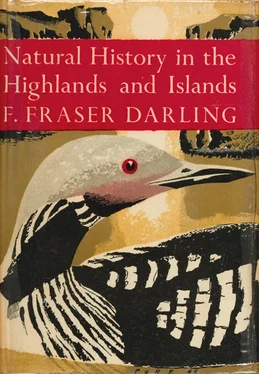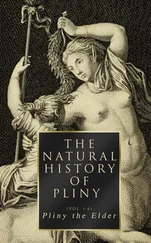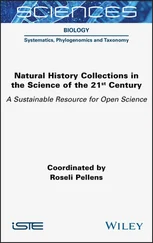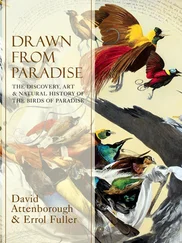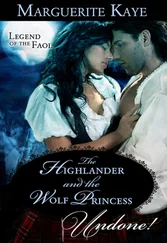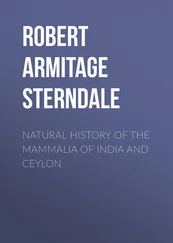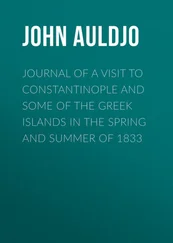1 ...7 8 9 11 12 13 ...21 The gneiss is difficult country to walk through: by keeping to the little glens it is impossible to steer a straight course for any distance and no one would attempt to go in a straight line over the hills. On the upper gneiss country where many detours are necessary round rock faces and soft spots, a speed of one mile an hour is quite good going. It is also quite easy to lose one’s self, for these little round hills are all very much alike.
The crofting townships on the gneiss are strictly coastal. Their arable grounds (Plate 7b) are usually tiny patches of an acre or less in the hollows or in the less steep faces of the rocks. Loch Laxford, a sea loch, shows some typical low gneiss country with crofts at Foindlemore and Fanagmore.
The gneiss tends to get higher the farther it goes inland. A’ Mhaighdean (the maiden) reaches 2,850 feet above the Dubh Loch in Ross, 10–12 miles from the sea as the crow flies. It forms a high cliff face on this hill of exceptional grandeur, a rare thing for the formation on the mainland. Its sea cliffs are nowhere impressive here because they are never sheer or higher than a couple of hundred feet. Even the Torridonian, a formation which one might expect to make magnificent cliffs, does not provide these in any quantity at the sea’s edge. The island of Handa, near Scourie and opposite Fanagmore at the mouth of Loch Laxford, is a splendid exception. The Torridonian rock is stratified horizontally, so the vertical breaks make nesting ledges for sea birds such as guillemots, razorbills and kittiwakes. There are sheer cliffs of nearly 400 feet on Handa, and in the little screes of earth among these, now covered with fescue and scurvy grass, there are large colonies of puffins and fulmar petrels. The white-tailed sea eagle nested on Handa until the second half of the 19th century. Handa is one of the few places on the Torridonian sandstone which provide true sea-bird cliffs. No other place on the formation can compare with it for numbers of auks, except perhaps Clo Mor, about four miles east of Cape Wrath, where there is a cliff of over 800 feet.
The splendour of the Torridonian is in the peaks it makes inland. Some are fantastic and others superb. There is only one Suilven and it is undoubtedly the most fantastic hill in Scotland (Plate 3b). It rises to 2,309 feet out of a rough sea of low gneiss. Seen from north and south it has a distinctive shape of a very steep frontal cliff and rounded top called Casteal Liath (the grey castle), then a dip and a lesser knob before a more gentle slope down to the east. But when seen from west or east the extreme thinness of the hill is apparent. Probably the Dolomites would be the nearest place where such an extraordinary shape of a hill could be seen. Suilven means the pillar which is a good name for the hill seen from the west. It is often likened to a sugar loaf, also. There are greyish-white quartzite boulders sprinkled on the top, yet there is a little alp of grass up there and an occasional bed of Rhacomitrium moss. The great terraces of Caisteal Liath itself are but thinly marked by such grasses and sedges as Festuca ovina forma vivipara and Luzula spicata as can send their roots far into the cracks.
One of the striking things about the Torridonian peaks of the far north-west is their isolation, caused by the vast denudation which has taken place, leaving these few hard cores of sedimentary rock overlying the wilderness of gneiss hillocks and innumerable lochans. The term hard core is here being used metaphorically and not geologically. North of Suilven and Loch Assynt is the massif of Quinag, five conical peaks capped with quartzite, with a fine rampart of cliff and scree on the west side, which is nearly three miles long. The massif is no higher than 2,653 feet, but how much more impressive is it than half a hundred three-thousand-footers in the Central Highlands! South of Suilven there is Cul Mor, 2,786 feet, surrounded on three sides by great precipices; and Stac Polly, 2,009 feet (Plate 4b and Plate 10) the narrow ridge of which is like one of those fairy castles of childhood tales perched on the top of steep slopes. Ben More Coigach rises to over 2,000 feet in under a mile from the sea as the crow flies. The air of this countryside with its lower rainfall is generally much clearer than farther south in the Highlands and adds to that sub-arctic quality which characterizes the area.
Before leaving this far northern corner, the ranges of Foinaven, 2,980 feet, and of Ben More Assynt, 3,273 feet, must be mentioned. The group culminating in Foinaven is without doubt the barest range in Scotland, and composed of that unyielding white rock, the Cambrian quartzite. The northern part is like a giant E, the crossbars being ridges peppered heavily with boulders which form screes again below the shoulders: the hollows of the E are fine corries on the slopes of which the snow bunting has bred. The southern part is a horseshoeshaped ridge of which Ben Arkle, 2,580 feet, is the western rampart. This hill of Cambrian quartzite with its banding of white scree may be viewed to perfection from the highroad on the shores of Loch Stack; but for the greatest glory of this range a six-mile trek must be made to reach the vast horseshoe corrie and Loch an Easain Uaine, the loch of the green falls. It is well to rest here awhile and realize that the pine marten is probably commoner in this neighbourhood than anywhere else in Britain, to remember the snow bunting up in the tumble of boulders and possibly see him feeding on the buds of Saxifraga oppositifolia. The alpine species of plant creep far down these bare hillsides and one wonders what there is here to recompense the deer for the energy used in attempting to graze these slopes. The boreal affinity of this range was further emphasized by the occurrence of alpine butterwort ( Pinguicula alpina ), which was found nowhere else in Britain but on the high tops of Sutherland and Ross; unfortunately this species may now be quite extinct, as it has not been found since 1900, according to Druce’s Comital Flora. The same authority puts 1794 as the last date on which this plant was found in Skye.
Ben More Assynt itself is a solid quartzite cap with igneous intrusions set upon a mass of Lewisian gneiss. There has been a series of geological overthrusts in the region, in which tumults areas of limestone have come to the surface. This limestone has affected the natural history of the whole region, causing a wealth of crustacean and other aquatic life on the waters affected by the limestone, differences in the temperature of the water of some streams which suddenly rise from the rock, allowing the formation of water-worn caves in which have gathered soil and bones of animals of earlier times. Such organic remains are rare in the Northern Highlands.
The comparatively low ground of all this northern region of the gneiss, so difficult of access and so plentifully strewn with lochs, is also a place where sub-arctic birch scrub (Plate IV) is common and there is a certain amount of hazel. There are large stretches of birch in Inverpolly Forest (Plate 4b) in the vicinity of Loch Sionnascaig, which is one of the most beautiful lochs in the whole Highlands. There are pristine birch-wooded islands in the loch where the grey lag goose bred not so long ago and where the pintail duck has bred recently. There is more birch round Lochinver and below the north face of Quinag, and many a stretch may be found on the hill far from the roads, in places which are almost unknown to the naturalist. Some day we may find the redwing building in these woods, for this bird has been heard singing here from time to time in April, and the redwing is essentially a native of the sub-arctic birch wood.
The eastern side of the extreme Northern Highlands is given up to extensive sheep-farming. The hills are of no great height and are of easy slope. The herbage is sweet and good. The largest sheep farms in Great Britain are here, some having upwards of 10,000 ewes. The breed kept is the Cheviot of the distinctive lustrous-woolled Sutherland type. The lambs are sold annually at the great sales at Lairg. No man was more responsible for the development of Cheviot sheep-farming in the North than Sir John Sinclair of Ulbster, in the 1790’s. The influence of sheep-farming on the natural history has been profound and will be given special attention in a later chapter.
Читать дальше
